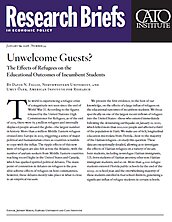We present the first evidence, to the best of our knowledge, on the effects of a large influx of refugees on the educational outcomes of incumbent students. We focus specifically on one of the largest recent inflows of refugees into the United States—those who entered immediately following the devastating earthquake on January 12, 2010, which killed more than 200,000 people and affected a third of the population in Haiti. We make use of rich, longitudinal education microdata from Florida—host to the majority of the Haitian refugees—to study this question. These data are exceptionally detailed, allowing us to investigate the effects of Haitian refugees on a variety of incumbent students, including nonrefugee Haitian immigrants, U.S.-born students of Haitian ancestry, other non-Haitian immigrant students, and so on. More than 4,000 refugee students entered Florida public schools by the end of the 2009-10 school year, and the overwhelming majority of these students enrolled in four school districts, generating a significant influx of refugee students in certain schools.
A number of studies have examined the effects of immigrants on the labor-market outcomes of host communities, and there have been several recent analyses of the effects of immigrants per se on the educational outcomes of incumbent students, although their conclusions have been mixed. But the effects of refugees might differ from the effects of immigrants on native communities because of the fundamental differences between these two groups in the manner in which they left their home countries. Immigrants typically make conscious choices to leave their countries of origin, seeking a better life elsewhere. On the other hand, the term “refugee” refers to people who have to flee their countries because of an imminent threat to their lives, such as armed conflicts, persecution, and/or natural disasters, and hence are more likely to be representative of, or even less advantaged and more marginalized than, the general population in their countries of origin. Refugees generally are more impoverished, with lower earnings than economic migrants, and have lower levels of education and language skills when they arrive.
And while refugees ultimately—after a period of 6 to 10 years—have higher labor-force participation and employment rates and similar welfare participation rates, relative to U.S.-born residents, they often enter the United States with low human capital and language skills and have initially poor labor-market outcomes and high rates of welfare usage. Therefore, it is plausible to expect that refugees might have a very different (and likely more adverse) effect on incumbent students as school districts and individual schools shift resources away from native students to accommodate the needs of refugees.
The biggest challenge in revealing the causal effect of refugees on incumbent communities is that refugee students are not randomly assigned to schools and communities. In fact, prior research has shown that refugees, and recent immigrants in general, are more likely to settle in neighborhoods with large numbers of immigrants from their country of origin. To deal with this selection issue, we make use of the within-school, across-grade variation in the number of entering refugees to explore the effects on the educational outcomes of existing students including test scores, disciplinary incidents, and student mobility across schools. We also use the birth dates of refugee students as an instrument for their grade placement to deal with the possible strategic placement of refugee students across grades within schools. We find precisely estimated zero effects (with occasional positive estimates as well) of refugees on the educational outcomes of incumbent students in the year of the earthquake or in the two years that follow, regardless of the socioeconomic status, grade level, or the birthplace of incumbent students.
Several factors might hinder the generalizability of our findings to other contexts. For instance, the effects of refugees fleeing the devastation of natural disasters such as the earthquake in Haiti might be different than the effects of refugees escaping violence and political persecution. Further, Florida has an established and sizeable Haitian immigrant population, and Haitian refugees enrolled in schools with considerable Haitian student populations. These schools might already have support systems in place to help recent immigrants from Haiti, such as Haitian Creole–speaking counselors, and hence might be more prepared to accommodate an influx of Haitian refugees, minimizing the adverse effects on existing students. Such support systems might not exist in other contexts (such as the Syrian refugee crisis in Europe) and hence the negative externalities of refugees on incumbent students might be more severe.
That said, Haitian Creole speakers were still a small minority of incumbent students in almost every refugee-receiving school prior to the 2010 earthquake. Just 6 percent of the incumbent student body of the typical refugee-receiving school spoke Haitian Creole, and only half of all Haitian immigrants (not counting native-born Haitian Creole speakers) are considered limited-English proficient. Limited- English proficient Haitian Creole speakers account for more than 10 percent of the incumbent student body population in only 78 schools, and more than 20 percent of the incumbent student population in just 26 schools. Therefore, it is unlikely that substantial educational or social services for Haitian immigrants existed in all but a relative handful of schools.
In summary, there appears to be little evidence that a sizeable influx of refugees has short-term negative consequences on native students. Taken together with new evidence that, after a period of adjustment, refugees have similar economic outcomes, across several dimensions, to comparable U.S.-born natives, and ultimately pay more in taxes than they receive in benefits, these findings indicate that the potential negative externalities associated with refugee admissions are likely lower than some may worry.
NOTE:
This research brief is based on David N. Figlio and Umut Özek, “Unwelcome Guests? The Effects of Refugees on the Educational Outcomes of Incumbent Students,” NBER Working Paper no. 23661, August 2017, http://www.nber.org/papers/w23661.
